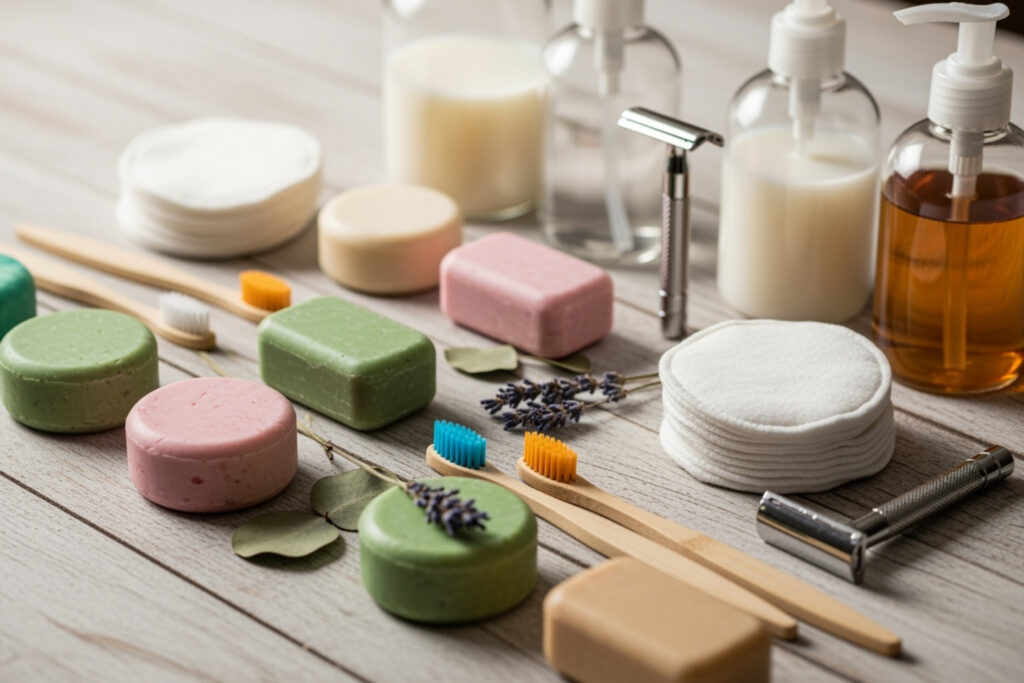Why Zero-Waste Beauty Is the Future of Self-Care
A zero-waste beauty routine focuses on eliminating packaging waste and harmful ingredients while maintaining effective skincare and makeup practices. Here’s how to get started:
Quick Start Guide:
- Replace single-use items – Swap cotton pads for reusable rounds, disposable razors for safety razors
- Choose solid alternatives – Try shampoo bars, conditioner bars, and solid moisturizers
- Find refillable products – Look for brands offering glass containers and refill programs
- Make DIY products – Create simple scrubs, toners, and masks at home
- Read labels carefully – Avoid microplastics like polyethylene and harmful chemicals
If you look around your bathroom, you’ll probably see plenty of plastic. From excess packaging to single-use cotton swabs, the potential for waste is all around us. The beauty industry creates more than 120 billion units of packaging annually, yet less than 9% gets recycled.
But here’s the good news: skincare is self-care, and going zero-waste doesn’t mean sacrificing your routine. It means being smarter about what you buy and use.
The problem is massive. Scientists estimate we’re eating microplastics equivalent to a plastic credit card each week. One household can go through 24 shampoo and conditioner bottles yearly. The beauty industry uses 10.4 million tons of water annually, much contaminating fresh waterways.
The solution is simpler than you think. You can shop smart and work towards a zero-waste skincare routine by limiting what goes to landfill. This guide will show you practical steps to reduce waste without compromising your glow.
Going zero waste has helped many people save thousands of dollars because it teaches you to be picky and cut impulse purchases. You’ll invest in quality products that last longer and work better.
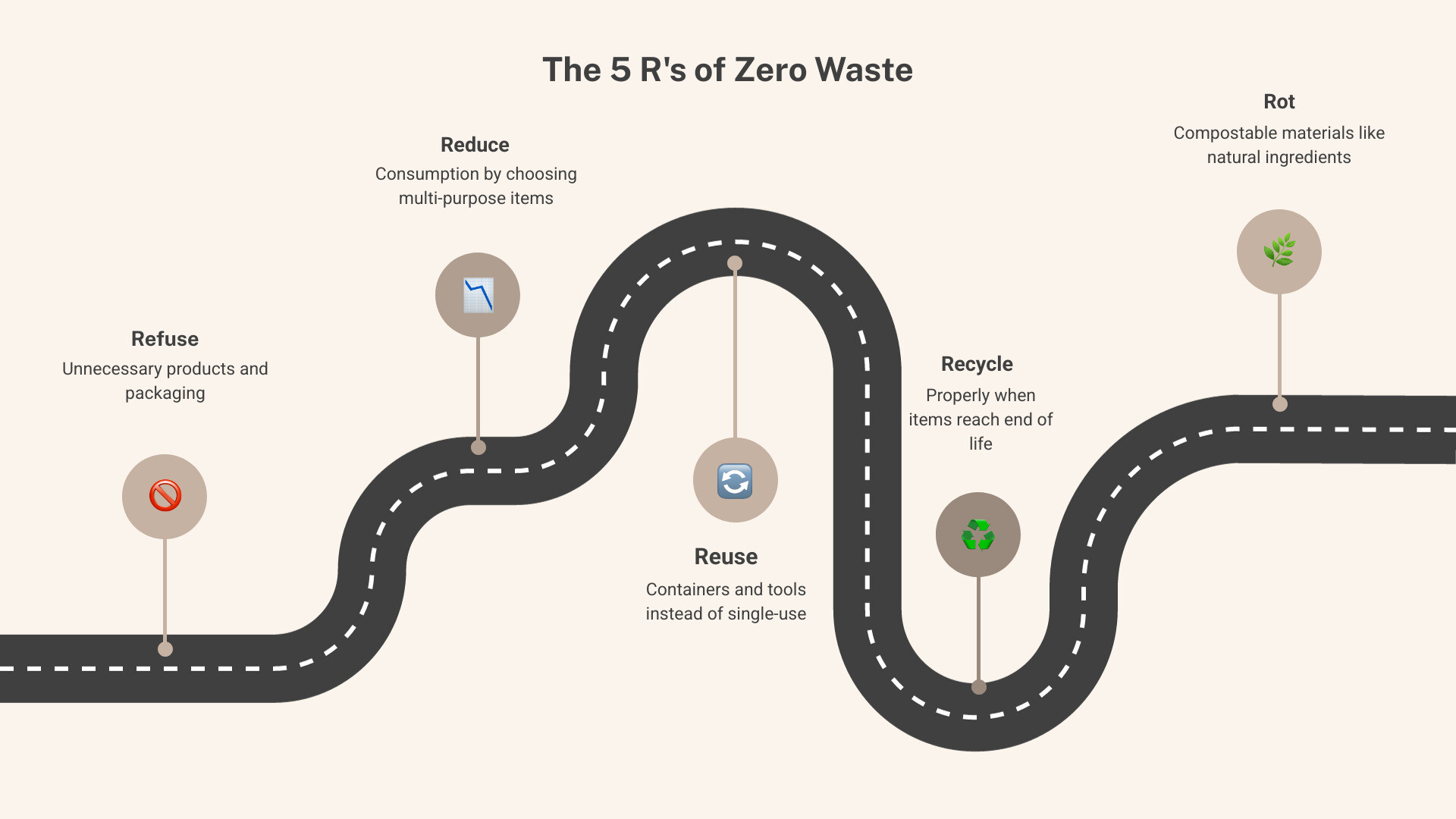
Explore more about Zero-waste beauty routine:
The Environmental Cost of Your Current Beauty Routine
While skincare is a form of self-care, it’s important to consider its environmental impact. The beauty industry, while making us feel good, also leaves a significant footprint on our planet.
Over 120 billion units of beauty packaging are created every single year, but less than 9% gets recycled. Many beauty containers are made from mixed materials, making them difficult for recycling centers to process. As a result, most of it ends up in landfills or polluting our environment.
The issue isn’t just the sheer quantity of waste; it’s also the type. Single-use plastic packaging alone accounted for more than half of the world’s plastic waste in 2015. And the projections aren’t pretty: we might produce more single-use plastic in the next ten years than we have in all of history since 1950. Think about those everyday items like single-use wipes – in the US alone, over 20 million pounds of them are tossed daily! Many of these contain plastic fibers, breaking down into something even more concerning: microplastics.
Speaking of microplastics, these tiny plastic particles are a huge problem. They’re often hidden in your scrubs, moisturizers, and even products with a bit of sparkle. While some “microbeads” have been banned, there are still over 500 different microplastic ingredients lurking in cosmetics. The scary truth? Scientists believe we’re all already consuming microplastics equivalent to a plastic credit card every single week, as these tiny bits can enter our food chain and even our blood. You can learn more about how microplastics are found in human blood in this Guardian article.
But it’s not just plastic. Many traditional beauty products contain ingredients that can harm both us and the environment. Take chemical sunscreens, for instance. Ingredients like oxybenzone and octinoxate, commonly found in these products, are known to harm marine life, especially delicate coral reefs. When we swim, these chemicals wash off, threatening vibrant underwater ecosystems. It’s a real threat to coral reefs, as explained by NOAA.
And let’s not forget water! The beauty industry uses a massive amount of water. In 2020 alone, an incredible 10.4 million tons of water were used, and a lot of that water became contaminated before flowing into our fresh waterways. This highlights a big need for more water-friendly products and practices in our daily routines.
Understanding these impacts is the very first step toward building a more sustainable beauty routine. It’s about making conscious choices that are good for you and good for the planet. For even more detailed information on these topics, dive into our resources on Sustainability In Skincare and explore the latest Clean Beauty Industry Statistics. This knowledge is key to truly embracing a zero-waste beauty routine.
Your Step-by-Step Guide to a Zero-Waste Beauty Routine
Transitioning to a zero-waste beauty routine might seem like a monumental task, but it’s entirely achievable and rewarding. The secret is to start small, focusing on progress over perfection. You don’t have to change everything at once; even simple, conscious choices can make a significant difference.
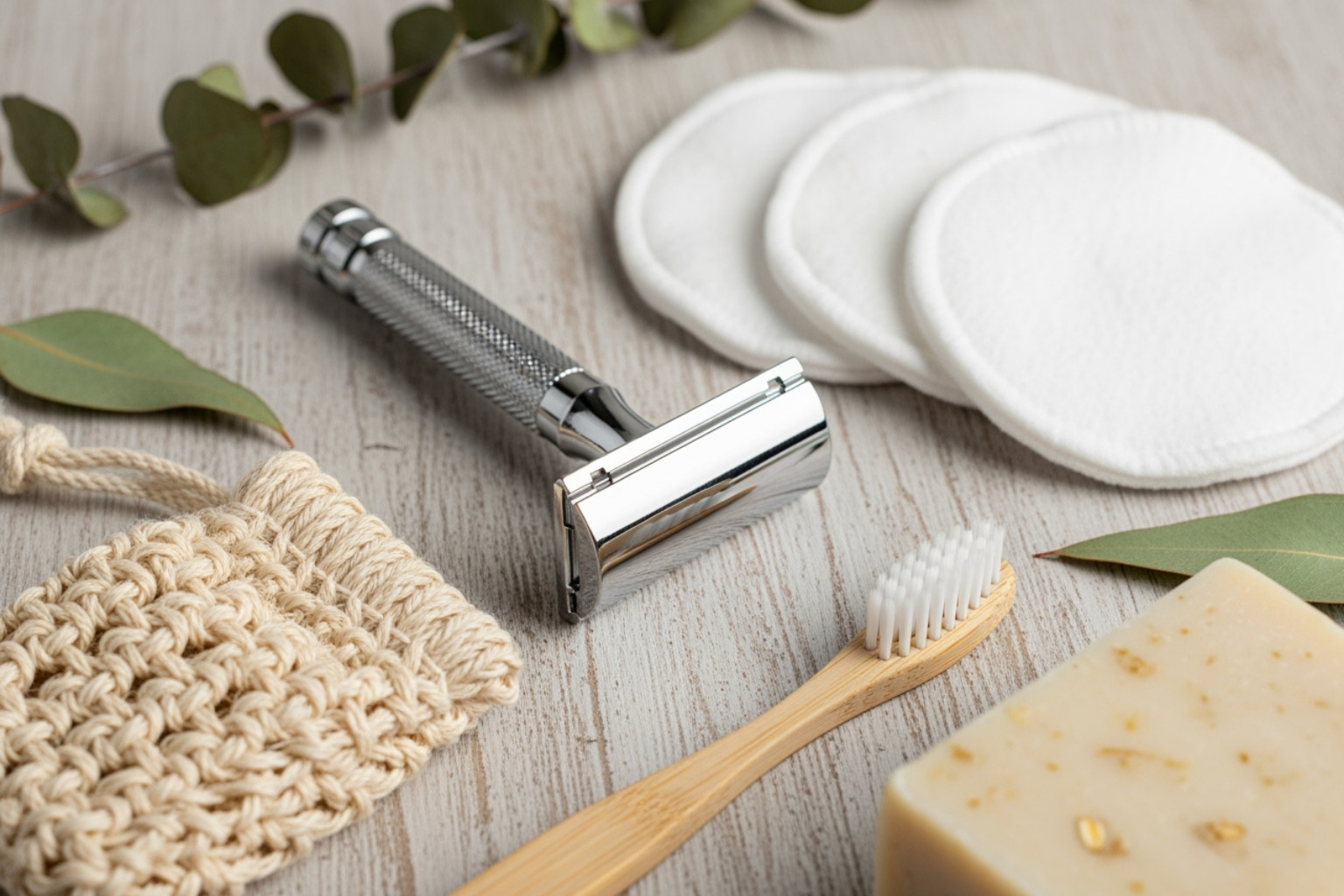
1. Start with Simple Swaps: The Low-Hanging Fruit
The easiest way to begin your zero-waste journey is by replacing single-use items with durable, reusable alternatives. These “low-hanging fruit” swaps are typically straightforward and have a big impact on reducing daily waste.
- Reusable Cotton Rounds: Instead of disposable cotton pads for makeup removal or toner application, switch to reusable ones made from organic cotton or bamboo. They work exactly like disposable ones but can be washed with your regular laundry. Many find them an “upgrade” because they pick up makeup like a magnet!
- Bamboo Toothbrushes: A simple yet effective swap. Bamboo toothbrushes are biodegradable, unlike their plastic counterparts that linger in landfills for centuries.
- Metal Safety Razors: While they might seem intimidating at first, safety razors offer a close shave and significantly reduce plastic waste from disposable cartridges. The blades are recyclable (just collect them in a steel can and take them to a specialized metal recycling facility). Plus, they can be more economical in the long run.
- Reusable Swabs: Think beyond cotton swabs. Reusable silicone or metal buds can replace single-use plastic ones for various beauty tasks.
- Loofah or Natural Sponge: Replace plastic loofahs, which can harbor bacteria and need frequent replacing, with natural loofahs or bamboo scrub brushes. These alternatives are more sustainable and can be composted at the end of their life.
These small changes might not feel on their own, but collectively, they significantly reduce your bathroom waste. For more ideas on eco-friendly beauty, check out our insights on Ecofriendly Bamboo Makeup Brushes Set and Eco Friendly Beauty Routines.
2. Accept Solid Alternatives
One of the biggest culprits of plastic waste in our bathrooms is liquid products packaged in plastic bottles. The good news is that many of these now have fantastic solid alternatives!
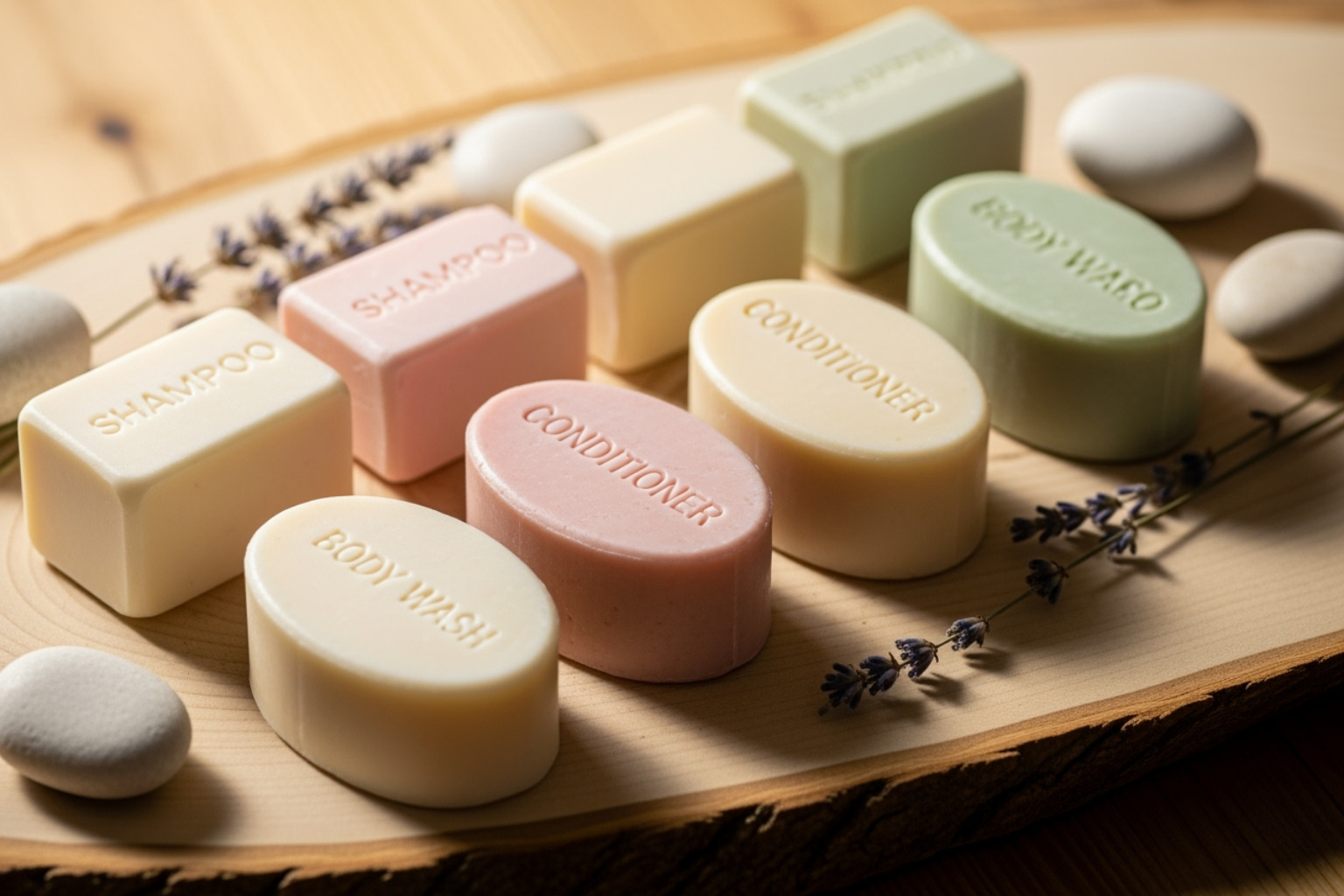
- Solid Shampoo Bars and Conditioner Bars: These are perhaps the most popular solid swaps. They are highly concentrated, often last much longer than bottled versions, and come in minimal or compostable packaging. One user noted that switching to bar shampoo and conditioner helped them save 24 bottles a year for a two-person household!
- Solid Lotion Bars: Instead of pump bottles, solid lotion bars melt with your body heat, providing moisturization without the plastic.
- Toothpaste Tablets & Mouthwash Tabs: These convenient, pre-portioned alternatives eliminate the need for plastic tubes and bottles. You simply chew a tablet and brush, or dissolve a tab in water for mouthwash.
The benefits of solid alternatives are numerous:
- Reduced Packaging: They often come in cardboard boxes or are completely package-free.
- Travel-Friendly: No liquids mean no spills, and they’re perfect for carry-on luggage.
- Concentrated Formulas: Many solid products are highly concentrated, meaning a little goes a long way, saving you money in the long run.
3. Rethink the Container: The Power of Packaging and Refills
Beyond solid products, we can also make a huge impact by choosing products that come in sustainable packaging or offer refill options. This is where the power of conscious consumerism truly shines.
- Refillable Products: An increasing number of beauty brands are offering products designed to be refilled. This means you buy a durable container once, then purchase refills in minimal packaging (like pouches or concentrated tablets) to replenish the product. This significantly reduces single-use waste. Some innovative brands even offer systems where you return empty containers to them for cleaning and refilling.
- Glass Jars: Glass is endlessly recyclable and can be easily repurposed at home. Many skincare products, such as moisturizers and balms, are available in glass jars.
- Aluminum Tubes and Tins: Aluminum is a fantastic material for beauty packaging because it’s lightweight, durable, and 100% recyclable. In fact, approximately 75% of all aluminum ever produced is still in use today because it can be recycled repeatedly without losing quality, requiring 95% less energy than making new aluminum.
- Compostable Packaging: Some brands are innovating with packaging made from compostable materials, which can break down naturally at the end of their life.
- Brand Take-Back Programs: Support brands that actively take back their empties for recycling or upcycling. This closes the loop and ensures proper disposal.
- Bulk Buying: For essential products that might still come in plastic, buying larger, bulk sizes can reduce the overall plastic consumed per use. This is a practical compromise when a fully zero-waste option isn’t available or suitable for your needs.
When you rethink the container, you’re not just reducing waste; you’re also encouraging brands to adopt more sustainable practices. For more details on packaging solutions, explore our insights on Eco Friendly Skin Care Packaging and Plastic Free Skincare Brands.
4. Become a DIY Beauty Alchemist
If you truly want to control the ingredients in your beauty routine and minimize waste, becoming a DIY beauty alchemist is a fantastic path. Making your own products can be surprisingly simple, cost-effective, and empowering.
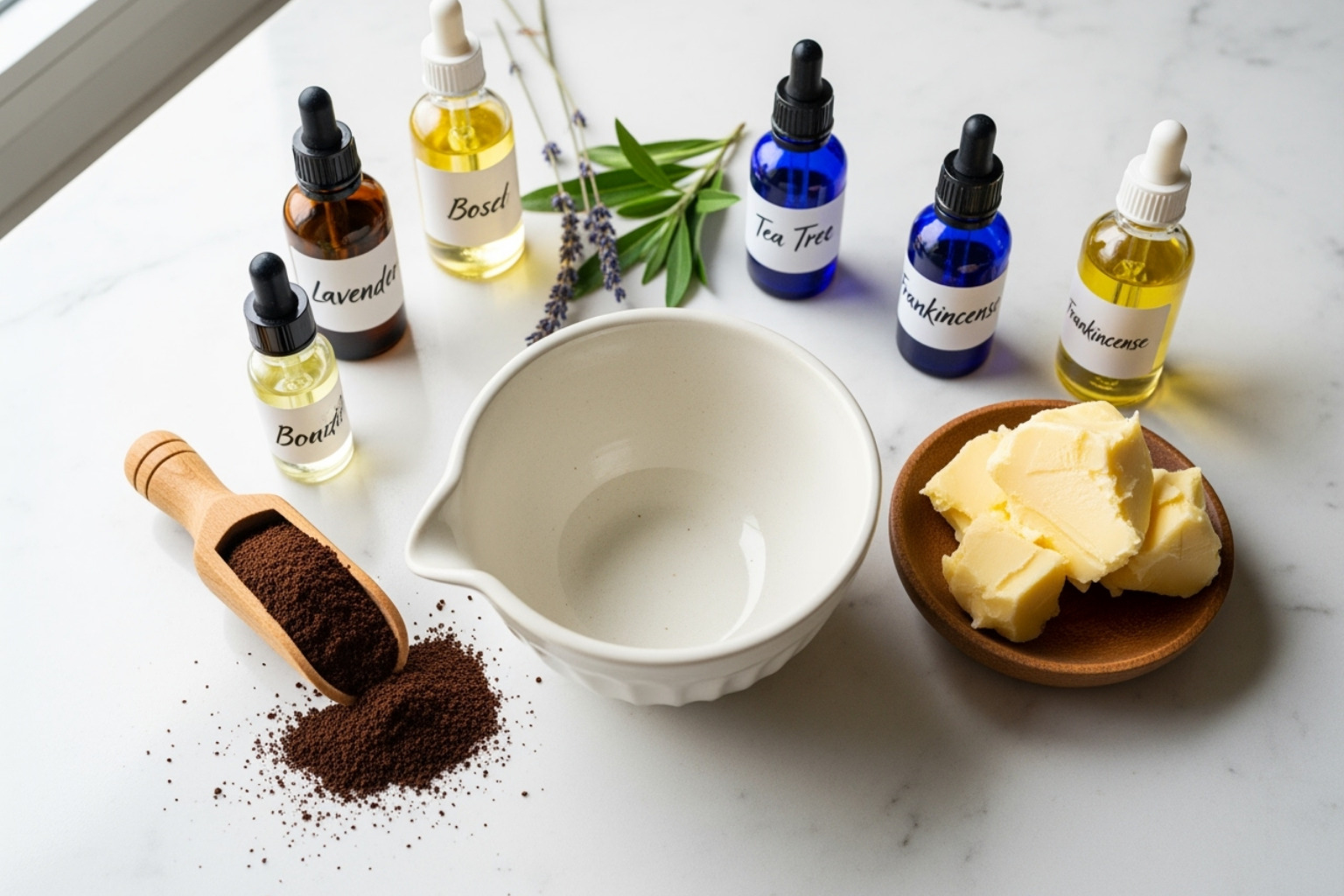
- Homemade Recipes: We can create a surprisingly wide range of beauty products from scratch using natural, bulk ingredients. This allows us to avoid unnecessary chemicals and packaging. For instance, homemade toothpaste can take about 30 seconds to make and cost about $0.40, compared to $6.00 for a natural store-bought version. Homemade lotion can cost $1-$2, significantly less than a $14+ store-bought version.
- Control Over Ingredients: When you make your own, you know exactly what’s going into your products. This is especially beneficial if you have sensitive skin or want to avoid specific allergens. You can prioritize organic, vegan, and fair-trade ingredients.
- Cost Savings: While there might be an initial investment in staple ingredients, DIY beauty often proves to be significantly cheaper in the long run. One individual found that making their own products saved them time, money, and gained freedom over their routine.
Here are some simple DIY recipes to get you started:
- Coffee Body Scrub: Don’t let those coffee grounds go to waste! Mix used coffee grounds with a little coconut oil (or another carrier oil) and a touch of sugar for an exfoliating, invigorating body scrub.
- Sugar Lip Scrub: Combine a teaspoon of sugar with half a teaspoon of honey and a drop of olive oil for a quick and effective lip exfoliant.
- Rosewater Toner: Simply distill fresh rose petals in water or purchase pure rosewater in a glass bottle. This makes a gentle, natural toner for your skin.
- Aloe Vera Cream: Mix two tablespoons of aloe vera gel with one teaspoon of your favorite facial oil (like jojoba or sweet almond oil) for a simple, hydrating cream.
- Hands and Lips Butter: Melt together solid butters like shea butter and a bit of coconut oil. Pour into small reusable tins, and you’ll have a nourishing balm for dry hands and lips.
Making your own products doesn’t have to be time-consuming. Most of these recipes take only a few minutes, which is often less time than it would take to walk to the store and back to buy an item. It’s about simplifying your life and gaining control. For more inspiration and recipes, dive into Natural Beauty Diy and Natural Skincare Tips.
Decoding Labels and Navigating Challenges
As we continue our journey toward a zero-waste beauty routine, one of the most powerful steps we can take is becoming a super sleuth for product labels. Understanding what’s in our products is incredibly important, not just for our skin, but for the health of our planet too. It’s all about ingredient awareness and making informed choices. We know it can feel a bit overwhelming at first, but think of it as empowering yourself! Sometimes, perfect zero-waste isn’t always possible for every single item, and that’s okay. It’s about progress, not perfection, and finding those common compromises that work for you. For a deeper dive into decoding labels, check out our guide on Beyond The Label How To Read Clean Beauty Ingredients Like A Pro and explore more about Non Toxic Skincare.
How to Avoid Microplastics and Harmful Chemicals
A big part of smart label reading is knowing how to spot and avoid microplastics and other chemicals that aren’t so friendly to us or the environment. Microplastics, those tiny plastic bits, are a huge concern because they stick around forever and can even end up in our bodies.
When you’re reading an ingredient list, keep an eye out for terms with “poly” in them. These are often hidden microplastics! Some common ones to watch for are Polyethylene (PE), Polypropylene (PP), and Nylon (PA), along with Polyurethane (PUR), PMMA, PTFE, and PET. There are actually over 500 different microplastic components that can sneak into cosmetics, so it’s a good idea to use apps or websites that help you identify them. For a really comprehensive guide, you can always check out resources like Guide to microplastics.
Beyond plastics, let’s talk about other chemicals that can cause trouble. Take chemical sunscreens, for example. Ingredients like Oxybenzone and Octinoxate are known to harm marine life, especially delicate coral reefs. They’ve even been banned in places like Hawaii because of their Threat to coral reefs when they wash off our skin. Instead, look for mineral-based sunscreens with non-nano zinc oxide and titanium dioxide, which are generally considered much safer for our oceans. You might also want to be cautious of ingredients like triclosan, which can be an endocrine disruptor, and sodium lauryl sulfate (SLS). By understanding these ingredients, we can make healthier choices for ourselves and the planet. To learn more about common beauty terms, head over to our Ingredient Glossary Clean Beauty Terms You Should Know.
Navigating Hard-to-Swap Products
While we’ve made amazing strides with many zero-waste beauty swaps, let’s be real – some products are still a bit tricky to find in truly waste-free formats. And that’s completely normal! It’s important to acknowledge these common challenges without feeling like you’re failing.
Makeup can be particularly challenging. Think about products like mascara, foundation, or eyeliner. They often need specific applicators or sterile packaging to work their magic and stay fresh. While some brands are starting to offer refillable mascara or products in glass or metal, it’s not always easy to find your perfect shade or formula in a truly zero-waste option. Sometimes, we might find ourselves choosing ‘low-waste’ options, like highly recyclable packaging, over strict ‘zero-waste’ for the sake of performance or personal needs.
Sunscreen is another one. We mentioned it earlier, but finding an effective and safe sunscreen that’s also zero-waste can be a bit of a quest. While there are mineral options available in tins or aluminum tubes, ensuring it suits your skin and provides enough protection is key. For some, especially those with sensitive skin, specific medical needs might mean choosing a product that comes in plastic, and that’s okay. Your health always comes first.
And then there are liquid serums and specialized treatments. Products with delicate active ingredients often need airtight, precise packaging to stay effective. This can make them tough to find in truly zero-waste forms.
When you hit these little roadblocks on your zero-waste beauty routine journey, here’s how we at Beyond Beauty Lab suggest you approach them:
- Prioritize Effectiveness: Especially for essential items like sunscreen or treatments for specific skin conditions, choose what truly works best for your health and needs first.
- Seek Low-Waste Options: If a perfect zero-waste item isn’t available, look for products that come in highly recyclable materials like glass or aluminum. Brands that use a high percentage of recycled content or offer take-back programs are also fantastic choices.
- Use Up What You Have: This is a big one! The most sustainable product is the one you already own. Don’t toss products just because they’re not zero-waste. Use them completely before you start looking for new, greener alternatives.
- Accept Minimalism: Sometimes, having a smaller, more curated collection of products means less waste overall, no matter the packaging. Focus on quality over quantity.
The path to a zero-waste beauty routine is all about continuous improvement and making mindful choices, not about being perfect. We truly celebrate every single step you take to reduce your environmental footprint. For more inspiration on finding sustainable makeup options, check out our guides on Eco Friendly Makeup Brands and Cruelty Free Makeup.
Frequently Asked Questions about a Zero-Waste Beauty Routine
As you explore the wonderful world of sustainable self-care, it’s completely natural to have questions. Transitioning to a zero-waste beauty routine might bring up a few concerns, and we’re here to gently address them. Think of us as your friendly guides on this beautiful journey!
Are zero-waste beauty products as effective as conventional ones?
Oh, this is such a common misconception, and we’re thrilled to set the record straight! The short answer is a resounding yes, zero-waste beauty products can be just as, if not more, effective than their traditional counterparts. It’s easy to assume that if it comes without fancy plastic packaging, it might be lacking in performance, but that’s simply not true!
The effectiveness of any beauty product truly comes down to its ingredients and how they’re formulated, not the container they come in. In fact, many eco-conscious brands prioritize high-quality, potent natural ingredients, often cutting out unnecessary fillers and harsh chemicals that traditional products might include to reduce manufacturing costs. Take solid shampoo bars, for example; they’re often highly concentrated, meaning a small bar can last as long as two or three regular shampoo bottles. That’s serious power in a little package! When you choose products that are kind to the planet, you’re often choosing ones that are incredibly kind to your skin and hair, too. Many Natural Sustainable Skincare Products use powerful ingredients that deliver real results without the plastic waste.
Isn’t a zero-waste routine expensive and time-consuming?
We hear you! It might seem that way at first glance, especially if you’re eyeing a sleek metal safety razor or a beautiful refillable glass jar. Yes, some initial investments, like a durable safety razor or reusable cotton rounds, might have a slightly higher upfront cost. But here’s the magic: these items are designed to last, and they almost always save you money in the long run. Think about it – those safety razor blades are pennies compared to costly disposable cartridges, and a sturdy bamboo scrub brush will outlive countless plastic loofahs.
And what about time? You might imagine hours spent concocting potions in your kitchen. But often, the opposite is true! Making your own products can actually be a huge time-saver. As one advocate shared, whipping up homemade toothpaste can take about 30 seconds. That’s “exponentially less time than I would spend walking to the store and back to buy an item,” isn’t it? Plus, embracing a zero-waste beauty routine often encourages a more mindful, minimalist approach. You buy less, you declutter your space, and you stop those impulsive purchases. Many people find they save significant money over time by becoming more selective and investing in quality items that last. It’s all about adopting a Clean Beauty On A Budget Smart Tips For Glowing Skin mindset.
What if I can’t be perfectly zero-waste?
This is, without a doubt, the most important question, and we want to give you the warmest, most reassuring answer possible: perfection is not the goal. The term “zero-waste” can feel incredibly intimidating, implying an impossible standard in our modern world. But please, let that pressure go!
Your goal isn’t to be “perfectly” zero-waste; it’s about reduction. Every single step you take, no matter how small, is a victory for our planet. Don’t feel like you need to toss out every plastic item in your bathroom right now. Instead, focus on using up what you already have. Once a product runs out, then make a conscious choice to replace it with a more sustainable alternative.
Embracing a “low-waste” approach, where you consistently strive to minimize your environmental footprint, is a truly significant win. It’s about building a routine that genuinely meets your needs while reducing waste whenever and wherever you can. Your individual efforts, when combined with those of others, create a powerful ripple effect. You’re already making a difference just by being here and considering these changes! We encourage you to create Sustainable Beauty Practices that feel good and fit seamlessly into your life, ensuring they’re long-lasting and manageable for you. You’ve got this!
Conclusion
Starting on a zero-waste beauty routine is truly a powerful way to align your self-care with your deepest values. It’s about nourishing yourself while also nurturing our beautiful planet. We’ve seen how those seemingly small daily choices can add up, contributing to big environmental concerns like plastic waste, microplastics, and even significant water usage in the beauty industry.
But here’s the exciting part: we’ve also mapped out clear, actionable steps you can take to make a genuine difference. We’ve talked about making those easy simple swaps – think reusable cotton rounds instead of disposable ones, or a sturdy safety razor. We explored embracing solid alternatives for things like shampoo and lotion, which often last longer and come with zero plastic. And for the adventurous, we even touched on becoming your own DIY beauty alchemist, creating amazing products right in your kitchen! Plus, we learned the importance of rethinking packaging with refills and knowing how to decode labels to avoid sneaky harmful ingredients.
We get it – the journey isn’t always perfectly smooth. Finding truly zero-waste options for every single product can be a challenge, and that’s okay. Here at Beyond Beauty Lab, we believe the goal isn’t perfection, but consistent progress. Every thoughtful choice you make to reduce, reuse, and refuse contributes to a much larger, positive movement. This shift to a zero-waste beauty routine isn’t about sacrificing your self-care; it’s an empowering upgrade! It means embracing cleaner ingredients, simplifying your routine, and enjoying the long-term benefits of a more mindful approach, including potential cost savings and a clearer conscience.
Your personal choices truly matter, adding up to a tangible positive impact and contributing to a healthier future for all of us. For more inspiration on eco-conscious choices that benefit both you and the planet, explore our comprehensive guide to Sustainable Beauty Products.

